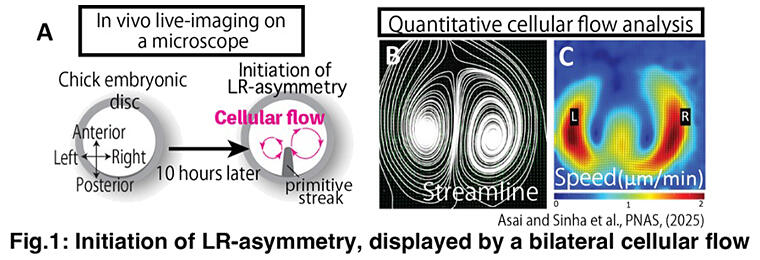A research group led by Lecturer Rieko Asai of the International Research Center for Medical Sciences at Kumamoto University, announced that their chick embryo analysis immediately after hatching revealed bilateral differences in cell movement. Such cell movement indicates that left-right asymmetry in the body exists earlier than previously assumed. The findings are expected to contribute to the elucidation of new mechanisms of development of human diseases due to asymmetry defects. The results were published in the Proceedings of the National Academy of Sciences of the United States of America PNAS on February 3.

(B) PIV analysis showing streamlines, indicating an asymmetrical bilateral rotation of the cellular flow during primitive streak extension.
(C) Speed plot, indicating the speed of the cellular flow during primitive streak extension. The speed was dominant on the right-side.
Provided by Kumamoto University
Many organisms have complex body structures that exhibit external bilateral symmetry but display left-right asymmetry in the internal organs. Body symmetry begins with midline morphogenesis in the embryonic stage; however, the origin of asymmetry has not been clearly known.
In this study, the research group performed live imaging of chicken embryos, which belong to the amniotes as humans, cultured under a microscope and analyzed cell movements using particle image velocimetry (PIV). It is a technique for visualizing and measuring fluids and is used to assess the flow of water and airflow generated by car running based on fluid dynamics.
The analysis showed a marked left-right difference in cell movement during the formation of a midline structure called the primitive streak. Cell movement plays an important role not only in organogenesis but also in the maintenance of homeostasis in life, including immune response and cancer metastasis. The disruption of cell movement can contribute to the development of serious diseases.
Asai said, "Many animals have complex structures that exhibit external bilateral symmetry but display left-right asymmetry in the internal organs, but many mysteries remain about the fundamental question of how these bodies are formed. This study asks when left-right differences in the body begin, which is a question to approach evolution and species diversity. I hope I could convey the fun of basic research. I am looking for students and research assistants who enjoy doing research with me, so please visit my laboratory."
Journal Information
Publication: PNAS
Title: Bilateral cellular flows display asymmetry prior to left-right organizer formation in amniote gastrulation
DOI: 10.1073/pnas.2414860122
This article has been translated by JST with permission from The Science News Ltd. (https://sci-news.co.jp/). Unauthorized reproduction of the article and photographs is prohibited.




